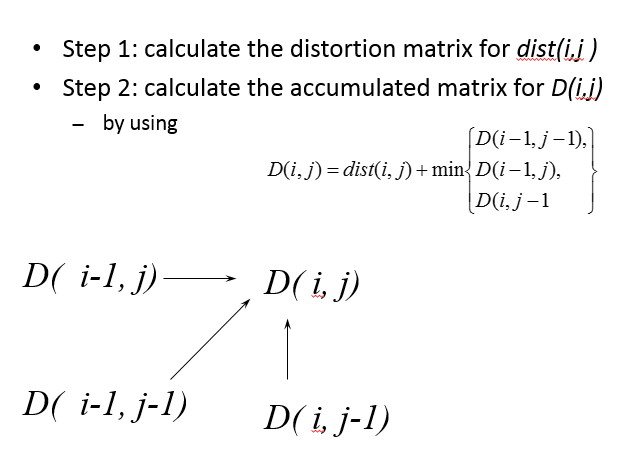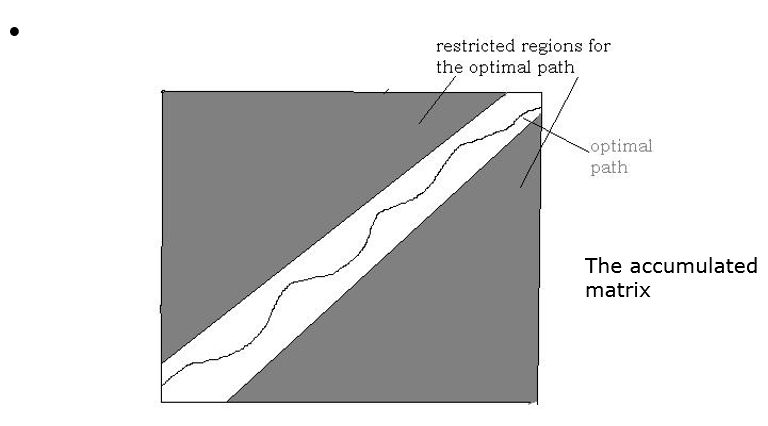最近认识了一个做Python语音识别的朋友,聊天时候说到,未来五到十年,Python人工智能会在国内掀起一股狂潮,对各种应用的冲击,不下于淘宝对实体经济的冲击。在本地(江苏某三线城市)做这一行,短期可能显不出效果,但从长远来看,绝对是一个高明的选择。朋友老家山东的,毕业来这里创业,也是十分有想法啊。
将AI课上学习的知识进行简单的整理,可以识别简单的0-9的单个语音。基本方法就是利用库函数提取mfcc,然后计算误差矩阵,再利用动态规划计算累积矩阵。并且限制了匹配路径的范围。具体的技术网上很多,不再细谈。
现有缺点就是输入的语音长度都是1s,如果不固定长度则识别效果变差。改进思路是提取有效语音部分。但是该部分尚未完全做好,只写了一个原形函数,尚未完善。


|
1
2
3
4
5
6
7
8
9
10
11
12
13
14
15
16
17
18
19
20
21
22
23
24
25
26
27
28
29
30
31
32
33
34
35
36
37
38
39
40
41
42
43
44
45
46
47
48
49
50
51
52
53
54
55
56
57
58
59
60
61
62
63
64
65
66
67
68
69
70
71
72
73
74
75
76
77
78
79
80
81
82
83
84
85
86
87
88
89
90
91
92
93
94
95
96
97
98
99
100
101
102
103
104
105
106
107
108
109
110
111
112
113
114
115
116
|
import waveimport numpy as npimport matplotlib.pyplot as pltfrom python_speech_features import mfccfrom math import cos,sin,sqrt,pidef read_file(file_name): with wave.open(file_name,'r') as file: params = file.getparams() _, _, framerate, nframes = params[:4] str_data = file.readframes(nframes) wave_data = np.fromstring(str_data, dtype = np.short) time = np.arange(0, nframes) * (1.0/framerate) return wave_data, time return index1,index2def find_point(data): count1,count2 = 0,0 for index,val in enumerate(data): if count1 <40: count1 = count1+1 if abs(val)>0.15 else 0 index1 = index if count1==40 and count2 <5: count2 = count2+1 if abs(val)<0.001 else 0 index2 = index if count2==5:break return index1,index2def select_valid(data): start,end = find_point(normalized(data)) print(start,end) return data[start:end]def normalized(a): maximum = max(a) minimum = min(a) return a/maximumdef compute_mfcc_coff(file_prefix = ''): mfcc_feats = [] s = range(10) I = [0,3,4,8] II = [5,7,9] Input = {'':s,'I':I,'II':II,'B':s} for index,file_name in enumerate(file_prefix+'{0}.wav'.format(i) for i in Input[file_prefix]): data,time = read_file(file_name) #data = select_valid(data) #if file_prefix=='II':data = select_valid(data) mfcc_feat = mfcc(data,48000)[:75] mfcc_feats.append(mfcc_feat) t = np.array(mfcc_feats) return np.array(mfcc_feats)def create_dist(): for i,m_i in enumerate(mfcc_coff_input):#get the mfcc of input for j,m_j in enumerate(mfcc_coff):#get the mfcc of dataset #build the distortion matrix bwtween i wav and j wav N = len(mfcc_coff[0]) distortion_mat = np.array([[0]*len(m_i) for i in range(N)],dtype = np.double) for k1,mfcc1 in enumerate(m_i): for k2,mfcc2 in enumerate(m_j): distortion_mat[k1][k2] = sqrt(sum((mfcc1[1:]-mfcc2[1:])**2)) yield i,j,distortion_matdef create_Dist(): for _i,_j,dist in create_dist(): N = len(dist) Dist = np.array([[0]*N for i in range(N)],dtype = np.double) Dist[0][0] = dist[0][0] for i in range(N): for j in range(N): if i|j ==0:continue pos = [(i-1,j),(i,j-1),(i-1,j-1)] Dist[i][j] = dist[i][j] + min(Dist[k1][k2] for k1,k2 in pos if k1>-1 and k2>-1) #if _i==0 and _j==1 :print(_i,_j,'\n',Dist,len(Dist[0]),len(Dist[1])) yield _i,_j,Distdef search_path(n): comparison = np.array([[0]*10 for i in range(n)],dtype = np.double) for _i,_j,Dist in create_Dist(): N = len(Dist) cut_off = 5 row = [(d,N-1,j) for j,d in enumerate(Dist[N-1]) if abs(N-1-j)<=cut_off] col = [(d,i,N-1) for i,d in enumerate(Dist[:,N-1]) if abs(N-1-i)<=cut_off] min_d,min_i,min_j = min(row+col ) comparison[_i][_j] = min_d optimal_path_x,optimal_path_y = [min_i],[min_j] while min_i and min_j: optimal_path_x.append(min_i) optimal_path_y.append(min_j) pos = [(min_i-1,min_j),(min_i,min_j-1),(min_i-1,min_j-1)] #try: min_d,min_i,min_j = min(((Dist[int(k1)][int(k2)],k1,k2) for k1,k2 in pos\ if abs(k1-k2)<=cut_off)) if _i==_j and _i==4: plt.scatter(optimal_path_x[::-1],optimal_path_y[::-1],color = 'red') plt.show() return comparisonmfcc_coff_input = []mfcc_coff = []def match(pre): global mfcc_coff_input global mfcc_coff mfcc_coff_input = compute_mfcc_coff(pre) compare = np.array([[0]*10 for i in range(len(mfcc_coff_input))],dtype = np.double) for prefix in ['','B']: mfcc_coff = compute_mfcc_coff(prefix) compare += search_path(len(mfcc_coff_input)) for l in compare: print([int(x) for x in l]) print(min(((val,index)for index,val in enumerate(l)))[1])data,time = read_file('8.wav')match('I')match('II') |
总结
以上就是本文关于Python实现简单的语音识别系统的全部内容,希望对大家有所帮助。如有不足之处,欢迎留言指出。感谢朋友们对本站的支持!
原文链接:http://blog.csdn.net/pp634077956/article/details/52916699










